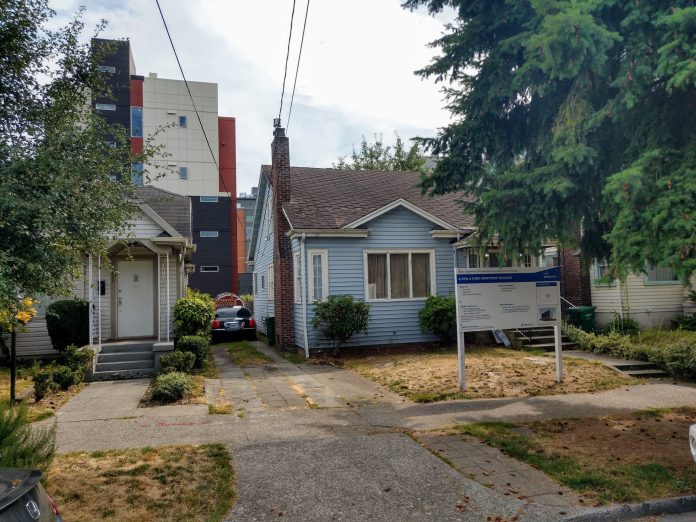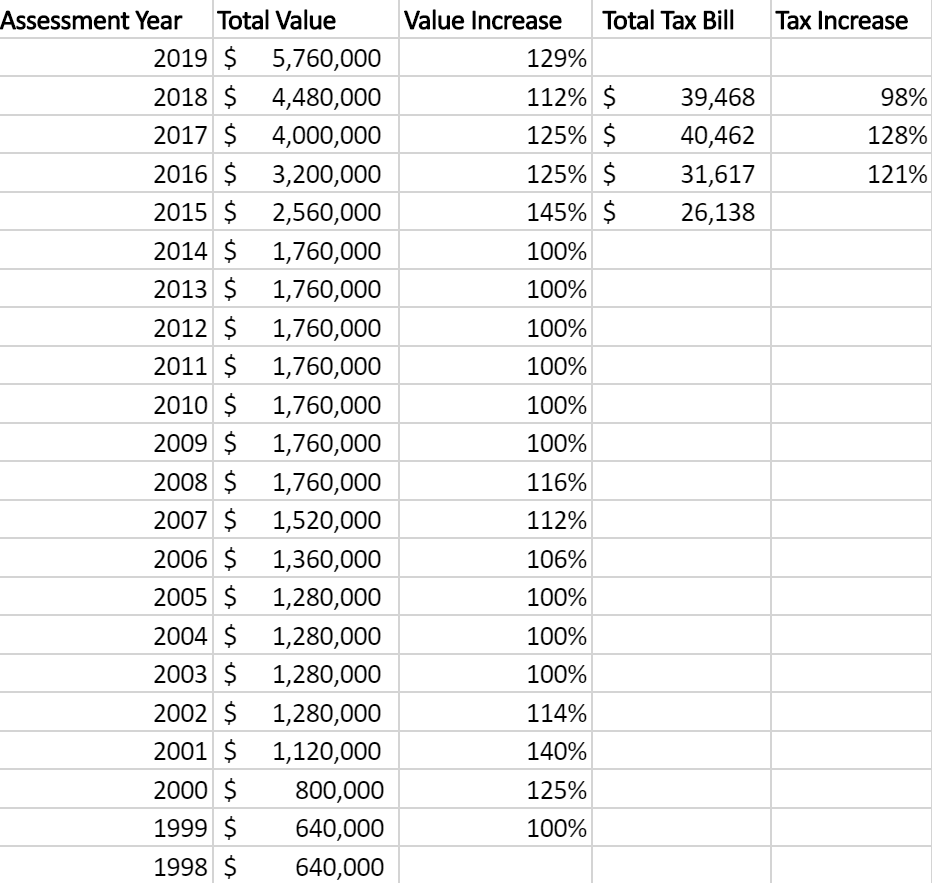
Alex Pedersen appears to not understand property tax in Washington State, despite having worked in government and his claims to “practical experience.” Or maybe he’s intentionally misleading voters to instill fear. He claimed on his campaign site: “Unmitigated upzoning can create economic disruptions and spike land values. Higher land values mean higher taxes, which are passed along to tenants.” (Since I started talking about this he’s updated his site to read: “Higher land values can mean higher taxes, which can be passed along to tenants“.)
In Washington, because we’ve got a complicated tax system, increasing land values does not mean higher taxes. Alex should know this as from his time as a legislative aide working on the city budget. In his response to The Stranger regarding this criticism, he elides with “It’s not helpful to take quotes out of context. In this case, it’s about preventing economic displacement and meant to compare a block that’s been upzoned to a neighboring block that hasn’t.”
However, not even this purported clarification shows an understanding of property taxes that one would expect from a candidate who claims “fiscal rigor” and budget experience among his qualifications. To the extent that an upzone does increase taxes, for homeowners the tax impact is negligible.
What increases property taxes is a four-part formula starting with the budget, adding in levy votes, then consideration of the total value of all property, and finishing with the value of a specific parcel.
First, budget. Washington property tax is designed to raise only the money allowed by the budget. If Seattle’s budget is $2 billion, then property tax can raise only $2 billion no matter what the value of property is (yeah, we’re ignoring the other tax revenue streams here).
Second, the increase in total property tax is limited to 1% per year (thank you, Frank Chopp!) unless voters approve a larger increase. Voters can also approve additional property tax levies, such as Sound Transit, parks, library, and housing levies. And yes, we approve a lot of levies (thanks to our #1 most regressive tax system). But note that these levies are for a dollar amount, not a tax rate!
Third, to determine the property tax, the state and counties figure out the total value of all property. This is divided into the total budget including levies. So, let’s say Seattle property is worth $200 billion. We need to make a budget of $2 billion. This creates a 1% tax rate ($2 billion/$200 billion=.01). Next year Seattle property value skyrockets to $400 billion. Our budget is now $2.02 billion–remember that 1% increase? The tax rate plummets to 0.505% ($2.02 billion/$400 billion), but the city still makes the $2.02 billion budget.
Fourth, the value of your property matters, but only as a fraction of the total property value. This is where it gets really weird. Let’s say your house is worth $1 million (cool for you!) and all Seattle property is valued at $200 billion. At a 1% tax, you pay $10,000. Now the value of all Seattle property doubles to $400 billion, but your property increases to just $1.5 million. The property tax rate has dropped to 0.505%, and you pay $7,575.

The result is that new construction, especially upzones that result in new construction, can lower property tax elsewhere. How so? Remember that 1% tax cap? It doesn’t apply to new construction or to improvements. This means that building more new housing or new commercial buildings means Seattle gets more tax money this year for services without needing to ask us for more taxes on our existing homes (rented or owned). And then, because that new construction increases the total value of property, it means we’ve diluted the value of any specific property. If we add $100 billion in new value to Seattle property, going from $400 billion to $500 billion in total value, unless we also increase our city budget by the same percentage (25%), our taxes will drop.
Pedersen wants all single-family homeowners to be concerned that their taxes will increase if their parcel is upzoned. But what would happen if we #RezoneSeattle to allow four floors and corner stores on every single-family parcel? In this best-case scenario, nothing much. Remember, the tax rate is set based on the budget. So if every property in Seattle increases in value, then no one’s taxes actually change, because, as explained above, the relative value of a given parcel remains the same and the tax rate drops to compensate.
But what about “economic displacement”?
You may say, “My property tax has not decreased for years!” Yes, this is likely true. Because we have the country’s most regressive tax system, voters in Seattle, King County, and Washington have passed levies to pay for civic goods. It’s these new levies, not the change in your property value, that’s been a primary driver of increased property tax. And as we’ve seen, Pedersen opposes most levies that allow us to pay for necessary civic services within the confines of our regressive tax system. (I should also note here that for households making $50,000 and more, Seattle has one of the lowest tax rates of major metropolitan areas.)
What about upzones? Pedersen claims these will drive out residents and businesses. An example frequently brought up is Hardwick’s in the University District. In March of 2018 the owner stated: “[For about five years], they’ve been increasing our property taxes 25 percent each year. It’s going to get worse because last year the city increased zoning.”
When we look at Hardwick’s property, which is comprised of three parcels, a few things stand out from their property tax assessment and bill. First, the value of their building (“Improvements”, in assessor-speak) is $1,000. The King County Assessor’s Office uses a $1,000 improvements valuation “if a property cannot generate an income that is needed to support the land value it is a property that is most likely to be redeveloped. Many of the [commercial] tax parcels in [Northeast Seattle] carry the land value and a token improvement value of $1,000”. Hardwick’s parcels have carried this designation since 1998, meaning the parcel has been ripe for redevelopment for two decades.

Second, the University District upzone was passed in February 2017. The percentage of valuation increase for Assessment Year 2017 was no more than in 2016. Then 2018 brought a lower increase, and 2019 saw an increase roughly on par with previous years. In other words, despite quadrupling the zoned capacity, it’s not clear how much of the valuation increase, if any, was due specifically to the upzone.
And third, if we compare the assessed values and the tax bill, we can see that the tax bill doesn’t exactly track the value increases. Despite the upzone, despite a valuation increase, their property tax actually decreased for Assessment Year 2018.
Finally, in this case the “economic displacement caused by upzones” argument rings hollow. Not only was Hardwick’s tax bill increasing before the upzone, but it decreased after the upzone, and–given the massive increase of developmental capacity from six floors to 24 floors–Hardwick’s could have easily redeveloped the parcel themselves, maintaining both their physical store and contributing a significant amount of new housing to Seattle. Hardwick’s wasn’t displaced; they chose to cash out on an 800% return on investment over 20 years and leave. (For more other examples, see “Highest and Best Use … or not“.)

That’s all well and good, but what about single-family homeowners who Pedersen prefers to court with fear of displacement? For single-family residential property, what if your property is upzoned and you don’t build something new? Your tax might go up because your property could be worth more as it has a higher potential value relative to others. We can see this by looking at two similar parcels in Wallingford that are literally across the street from each other.
In this case one parcel is SF 5000 and the other was zoned many years ago to LR1 (or more likely the single-family parcel was downzoned in one of our many downzones over the decades). The net impact to property tax? The LR1-zoned parcel pays 6% more property tax per square foot of land. This isn’t nothing, but for an upzoned parcel, a one-time minor bump in tax is hardly “economic displacement”. Were the SF 5000 parcel to be upzoned to LR1, the homeowner might see a $180 increase in property tax. (Note that this isn’t 6% on the entire tax bill, but just on the value of the land.)
Again, $180 per year isn’t nothing, but it doesn’t represent economic displacement.
The fear Pedersen peddles on property tax is unwarranted given his claim to be the experienced, fiscally accountable, and transparent candidate. By misleading the electorate, he’s committing political malpractice.
Wanna learn more so you can be better informed than an “experienced” candidate for city council? Check these out: a great explainer from Rachael Ludwick, the Washington State explainer, Spokane County’s explainer with cool 1990s graphics, and Klickitat County’s explainer also with graphics.
This post is a cross-post adapted from Paul Chapman’s medium blog. You can follow him on Twitter at @PoulChapman.

Paul Chapman
Paul Chapman lives on Capitol Hill, advocates for progressive urbanist causes, and is the current chair of the 43rd LD Democrats. You can follow him on Twitter at @PoulChapman.
